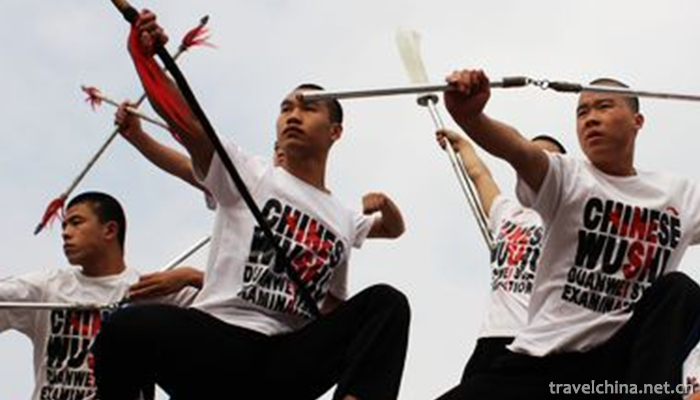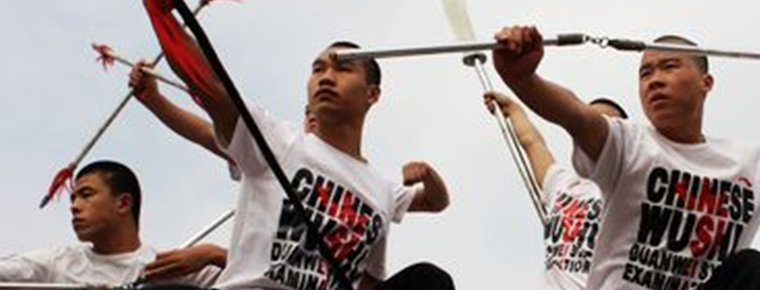Eighteen General Martial Arts
Eighteen General Martial Arts
A traditional term of Chinese Wushu, also known as "Eighteen Weapons" and "Eighteen Weapons", is commonly used in ancient Chinese operas and novels, referring to the use of various Wushu instruments and skills. The content and form of eighteen kinds of martial arts are very rich, which largely reflects the development of martial arts in that era. Modern people's understanding of "Eighteen General Martial Arts" refers to a wide range of weapons or skills.
On May 23, 2011, eighteen general martial arts were approved by the State Council to be included in the third batch of national intangible cultural heritage list.
evolution
As a military term, it appeared in military books, and "Eighteen General Martial Arts" was first found in the Collection of Cuiwei North by Huayue in the Southern Song Dynasty. The seven chapters of the book "Eight out of ten martial arts, and bow first", but did not give the specific content of "Eighteen general martial arts".
At the end of Yuan Dynasty and the beginning of Ming Dynasty, the second chapter of Shi Nai'an's Water Margin in Ming Dynasty said, "Shi Jin asks Wang Jiaotou every day to point out eighteen kinds of martial arts and teach them one by one from the beginning. What are the eighteen kinds of martial arts? Spears, hammers, bows, braces, swords, chains, axes, cymbals and halberds, batons and forks."
During the Wanli period of the late Ming Dynasty, the specific content of "Eighteen General Martial Arts" was expressed in a new way: "One bow, two crossbows, three guns, four knives, five swords, six spears, seven shields, eight axes, nine indigo, ten halberds, eleven whips, twelve bracelets, thirteen picks, fourteen covers, fifteen forks, sixteen palladium heads, seventeen cotton ropes, eighteen white strikes". "White Fight" means unarmed fighting. Boxing has always been paid attention to in Wushu practice. Ming Qi Jiguang pointed out in "Jixian Xinshu Quijie Essential Chapter of Quan Jingjie" that "Boxing seems to be unprepared for the war, but it is also the door for beginners to learn to enter the art by moving their hands and feet and being diligent in their limbs." Since then, although the contents of the eighteen general martial arts have changed, they are basically the same as this.
Since the Qing Dynasty, the eighteen kinds of martial arts have four main statements:
1. Refers to knives, guns, swords, halberds, legs, sticks, forks, rakes, whips, maces, hammers, axes, hooks, sickles, picks, crutches, bows and arrows, rattan cards.
2. Same as the arrangement, the last three items changed into generations, bows and arrows.
3. Refers to "nine long and nine short". Nine lengths are guns, halberds, sticks, indigo, forks, legs, hooks, mortise and rings; nine short are knives, swords, crutches, axes, whips, maces, hammers, sticks and pestles. The disappearance of bows and arrows of long-range weapons and cards or rattan cards of defensive weapons also reflects that modern practitioners are not good at bows and arrows and only teach routines.
4. It refers to 18 kinds of weapons called knives, guns, swords, halberds, axes, cymbals, hooks, forks, whips, maces, hammers, grasps, boring, sticks, bangs, sticks, crutches, meteor hammers and so on. This is also an arrangement accepted by most people today.
Significance
From this we can see that the so-called "eighteen general" is not limited to eighteen weapons, but an overview of various ancient martial arts. In fact, the Cold Weapon Age produced many weapons, far more than the "eighteen-size". During the late Qing Dynasty and the Republic of China, "Eighteen Weapons" became the necessary display of all martial arts halls, and became one of the symbols of Chinese martial arts and martial arts halls.


-
2.Mount Song
Songshan, known as the "foreign side" in ancient times, Xia and Shang Dynasties as "lofty" and "Chongshan", Western Zhou Dynasty as "Yue Shan", Songshan as the
Time 2018-10-30 -
3.Narati Scenic Spot
Narati Tourist Scenic Area, located in Xinyuan County, Xinjiang, is located in the hinterland of Tianshan Mountains, the eastern end of the Ili Valley
Time 2018-12-12 -
4.Jinshan City Beach Shanghai
Jinshan City Beach is located in Jinshan District of Shanghai, located in the southwest of Shanghai and the North Bank of Hangzhou Bay. It is adjacent to Pinghu and Jiashan City in Zhejiang Province
Time 2018-12-19 -
5.World Park
The World Park is located in Dabaotai, Huaxiang, Fengtai District, Beijing. It is 16 kilometers from the city center and 8 kilometers from Beijing West Railway Station. It is a national 4A-level sceni
Time 2018-12-19 -
6.Huangjinglaolin Scenic Spot
Huangjing Old Forest Scenic Spot is located at the junction of Sichuan and Guizhou provinces in southern Sichuan Province and northwest Gulin County. Its total planned area is 9122.6 hectares
Time 2019-01-18 -
7.Cai Luns Paper making Legend
Cailun Paper-making Stories and Legends are legends circulated in Cailun's fiefdoms, burial sites and experimental sites of Yangxian Longting and surrounding areas.
Time 2019-04-04 -
8.Straw weaving
Grass weaving is a popular folk handicraft. It makes use of the grass produced in different places to make materials locally and weave into various daily necessities
Time 2019-04-15 -
9.Pudong Publicity Book
Nanhui Xuanjuan is an ancient traditional art of rap and singing. Xuanjuan originated from "vulgar speaking" in Tang Dynasty and "Tanjing" in Song Dynasty. It is a term used by Bud
Time 2019-06-09 -
10.Centipede dance
Centipede dance, Guangdong traditional folk dance. Originated from Tongzhi in Qing Dynasty to Guangxu, it was initiated by Chen Chengjin, a native of Ximen, and Shi Wenyong, a good friend. It is a squ
Time 2019-06-29 -
11.Xiuyan Jade Carving
Xiuyan Jade Carving, one of the national intangible cultural heritage, is a local traditional art in Xiuyan Manchu Autonomous County, Liaoning Province.
Time 2019-07-08 -
12.Plant resources in Nanchong
There is only one kind of Metasequoia glyptostroboides introduced and cultivated in Nanchong City; there are two kinds of wild protected plants, namely, fragrant fruit tree and narrow leaf pygmy grass, and two kinds of cultivated Ginkgo biloba and Eucommia
Time 2020-12-17